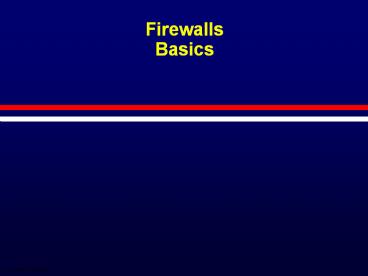Firewalls Basics - PowerPoint PPT Presentation
Title:
Firewalls Basics
Description:
Firewalls Basics Overview Why we have firewalls What a firewall does Why is the firewall configured the way it is Why Do We Have Firewalls?? Recent Network Security ... – PowerPoint PPT presentation
Number of Views:340
Avg rating:3.0/5.0
Title: Firewalls Basics
1
Firewalls Basics
2
Overview
- Why we have firewalls
- What a firewall does
- Why is the firewall configured the way it is
3
Why Do We Have Firewalls??
- Recent Network Security Compromises
- Pentagon Domain Name Server
- March AFB Web Server
- Senate Web Server
- Network hacking has been simplified by the
proliferation of tools available on the Internet - Satan
- Crack
- Ping of Death
4
Why Do We Have Firewalls??
Components
Your Policy Deny access to any service unless
it is expressly permitted implemented enforced
via a combination of
- Hardware,
- OS Software,
- Application Software
Each Component performs a different role in
implementing your policy
- Establishes a physical perimeter to protect your
internal assets. - Centralizes consolidates management
enforcement of network access policies. - Saves by consolidating security measures,
investments, admin. but ... - also consolidates your risks (all eggs in one
basket)
5
What does the Firewall Do??Overview
- Proxying
- Stateful Packet Inspection
- IP Filtering
- Access Control Lists
- Network Address Translation
- Logging
- Centralized Security Policy
- Type Enforcement
6
Proxying
- Proxies are applications running on the
firewall built to intercept communications for
specific protocols and will explicitly allow only
necessary, secure, and valid operations. - Proxies are written by the vendor to handle a
specific type of traffic (RealAudio, SQLNET) - Proxies examine all packets of a connection and
therefore exact a performance penalty
7
Stateful Packet Inspection
- Stateful Packet Inspection (SPI) technology keeps
tables to track the status of each connection, as
well as commands that appear in the data stream,
and regulates traffic flow accordingly. - The tables are checked before data is processed
by the OS of the firewall - Header information from the original connection
passes through the firewall unchanged if the
defined policy allows the access.
8
IP Filtering
- IP Filtering allows all ports for a particular
protocol (TCP,UDP,ICMP) to pass through the
firewall - IP filters allows packets to pass through
unaltered and does not check headers for traffic
types - IP filtering provides very little protection and
should not be used (Consider it a hole in the
firewall)
9
Access Control Lists
- Access Control List (ACL) is a mechanism that
permits IP addresses to communicate in accordance
to certain rules - ACLs are used in conjunction with proxies, SPI,
and IP filters - ACLs provide granularity to the control over
access
10
Network Address Translation
- Network Address Translation (NAT) hides the
addresses of all devices initiating connections
from inside your network by converting their
source address to the firewall's external
address. - NAT prevents external threats from gaining
knowledge of the internal network structure of
the base
11
Logging
- Firewalls provide a central logging point that
records all connections both successful and
failed - These logs can then be parsed to determine
problem areas ( i.e. Misconfigured internal
machines, person engaging in improper use of the
network)
12
Centralized Security Policy
- Reduces the number of systems that are exposed to
security risks as only the firewall is exposed to
attacks from the Internet - Gives a single point at which an administrator
can control network access to and from the
Internet - Simplifies security management by providing a GUI
13
Type Enforcement Advantages
- Provides breach containment
- Separates applications into domains
- Controls which resources each domain can access
- Software in a domain is granted access only to
resources it needs, and forbidden access to
anything else - An access violation is triggered if any access
outside of the current domain is attempted - Restricts malicious activity to the offending or
compromised domain - Unique to the Sidewinder firewall
14
Network Security Policy
- Defines overall roles and responsibilities of
network security - Defines security requirements, principles, and
policies - Network Infrastructure Services and Protocols
Policy - Listing of 33 infrastructure services and
policies, their vulnerabilities, and usage policy































